|
Allen Bryan WKLO News Q & A |
WKLO
Allen Bryan
was part of the WKLO news department throughout much of the '60s and
early '70s, first as a reporter/anchor and then as News Director. He
graciously answered our questions about the inner workings of the WKLO
news department and his time there as News Director.
How did you get to be WKLO news
director? What was your background in radio and news?
I was hired as evening newsperson at WKLO in May 1960. I had been in
radio for about 5 years starting when I was in high school. My job when
I was offered the position at WKLO was the News Director and only
newsperson of KCCO radio in Lawton, Oklahoma. Until I was hired at KCCO
I had been a radio announcer/DJ, doing a little bit of everything. My
only prior top 40 experience was at KSWO in Lawton for about 6 months in
late 1959.
While I attended the University of Oklahoma briefly after high school, I
did not have a degree. I still don't today. In the early '60s I
developed a philosophy that the most important thing you learn every day
is how much more you don't know, therefore the most important activity
in daily life is continuing to learn.
During my early career at WKLO I worked both as a newsperson and DJ at
the same time, doing a 9 a.m. to 12 noon record show and the afternoon
drive news shift every day. The news shift was a real challenge because
we did two five-minute newscasts an hour plus traffic reports, sports,
and other inserts during the hour, so I was on the air as much or more
than the DJ.
After I returned to WKLO from the Army in late 1963 I was primarily
working as a DJ until early 1965 when I returned to news. Ken Rowland,
who had been News Director when I started at WKLO, quit to go to work
for WLKY-TV at about that time. There was a period of two or three
months where no one was named to fill the position, then I was named
news director in 1965.
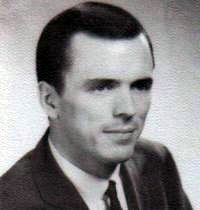
Allen Bryan (1967)
What were the responsibilities of
the WKLO News Director?
One of the primary responsibilities was working a regular on-the-air
news shift. While I was News Director I generally worked either morning
or afternoon drive. I also often had to fill in for people who were sick
or on vacation. This sometimes led to very long periods of consecutive
workdays. I think the longest I ever went was three weeks without a day
off.
My management responsibilities included scheduling the staff, making
assignments for outside news coverage, and shaping the way we covered
and reported the news. The latter included monitoring a large percentage
of our newscasts and providing feedback to the newsperson regarding both
content and delivery. I also did a lot of reading and research to stay
informed about things that were in the news.
Another area of focus was improving the technical resources and quality
of the tools we used to broadcast the news.
As WKLO's News Director, what was a typical day like? How much of it
was managing people vs. actually directly getting news on the air
yourself?
When I was doing the morning drive newscasts, I would get up at about 4
a.m. every weekday and try to get to the station by 5 a.m. My first
newscast was actually at 6:25 a.m., but I wanted time to prepare for the
morning by checking sources, clearing and editing the UPI teletype from
overnight, reading the paper and following up any important stories that
were new, and to check on any left over stories from the night before.
We had a newsperson on until midnight and they would leave notes about
things that needed follow-up. I would also review the UPI audio feeds to
see is there were any good audio cuts I wanted to use.

The morning news shift was from 5-9 a.m. and between 6:25 a.m. and 9
a.m. there were six five-minute newscasts, as well as an hourly sports
report, and traffic condition reports whenever something happened.
Generally traffic was lighter in the morning than in PM drive except
when we had ice or snow. Then it was chaos, especially if we also had
school closings.
My last task at the end of the shift was to prepare a half-page news
headline sheet that we distributed in downtown restaurants every day. We
had our own print shop and a guy who would make the deliveries.
During the time I was doing the morning drive time newscasts, I would
generally arrive at the station sometime between 5-5:30 a.m., and leave
sometime around 5 p.m. in the afternoon. I had to go to bed by about
9:30 p.m. in the evening so I really only had about 4 hours a day of
personal time. I loved what I was doing and never saw it as a problem,
although I'm sure my wife and family did.
During the middle of the day, I would always be in close touch with the
newsroom, listening to all the newscasts, providing feedback to the
on-duty newsperson about delivery and content, answering questions,
making suggestions regarding follow up on news developments, changing
street reporters' assignments based on new developments, etc. We
generally always had 2-3 newspeople working on outside assignments
during the 9 a.m.-5 p.m. period.
I had a two-way radio in my car so I was in touch with the newsroom
anytime I was driving, and I also was generally available by phone if
they needed me. I listened to as many newscasts as possible when I
wasn't at work, and often called in to make suggestions or critique the
on-air presentation. Sometimes I literally felt like I was plugged in to
the station 24 hours a day. I remember one incident in particular where
my wife and I were watching a movie, and an usher walked down the aisle
paging my name. I went to the phone and learned that a fairly serious
racial incident had broken out in the West End. I took my wife home, and
went out to cover the story.
In short: I viewed it as a FULL TIME job. The only part of my schedule
that was ever controlled by someone else was when I was doing the on-air
news shift. No one told me I had to spend all those additional hours
glued to the station.
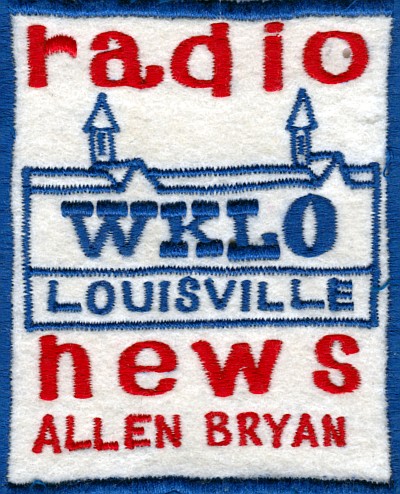
WKLO Jacket Patch
Who did the News Director report
to...the GM or the PD? How much say did either have in deciding what
news was covered and how it sounded? Any major disagreements with either
on how the news department was run or how the news was covered?
Interesting question. I never thought of myself as "reporting to"
anyone. If you asked me who I worked for I would say Ernie Gudridge,
the GM, but I had a very close working relationship with the PD,
especially when Terrell Metheny was there.
The history of news at WKLO was that from the late '50s when they went
Top 40 and Ken Rowland was hired, news was the lead programming feature
of the station. As far as I could tell in the first couple of years I
was there, nobody told the news department what to do. It was almost
like two different stations (music and news) occupying the same
frequency using the same call letters.
By the time Terrell Metheny arrived, and Ken Rowland left, things
changed and the news was considered to be part of the total programming
product. I don't recall ever having anyone in management telling me what
stories to run or not run, but there was a major change in the
programming influence over the sound of the news on the air. This
included tightening up the production values of the newscasts,
developing a more forceful and enthusiastic delivery style, etc.
One of the early things that Terrell insisted on was getting more tape
actualities in the newscasts, and shortening them. I recall that I was
pissed off about this as were most of the news people, and I set out to
establish a world record. I wound up having something like 15 separate
news actuality cuts in one five-minute newscast. Eventually Terrell
backed off of the numerical quota, and we all learned to edit tape more
carefully, and to seek out audio for stories.
Ultimately we made a number of major changes in the way the news was
presented on the air, including eliminating newscasts in midday and
evenings, but we never reduced our commitment to news, and newsmen
always had the right to go on the air whenever they had something worth
reporting.
I think the fact that I had been a DJ and understood the programming
values and concerns made it easy for me to be a supportive partner in
these changes. In addition the overall ratings success of the station
meant that we had an even larger audience for the news.
Were you ever asked to pull a story or not cover an event (say, by an
advertiser)?
I don't recall that ever happening. We probably did cover some stories
that we wouldn't have otherwise covered because of an advertiser
interest.
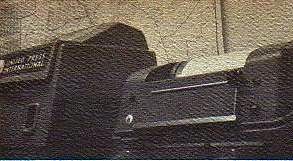
Besides the wire services, what
sources did you use to get news on the air at WKLO?
WKLO was a UPI (United Press International) member so that was our
source of wire copy. We also had a Weather Bureau teletype, and for
several years we had a teletype connection to the Louisville Police
internal teletype service which carried short summary crime reports that
were primarily for internal police department use. As far as I know we
were the only station in town to have this connection and we kept it
very quiet. We actually had the police teletype in a dark corner of the
basement of the station, and would check it several times a day and tear
off the accumulated reports. We would never use a story from the police
teletype without getting the info directly from someone at the police
department on the phone.
We also eventually subscribed to the UPI Audio Service which provided
several feeds a day of news actualities and voice reports from reporters
around the world. We would also often make direct phone calls on
national news stories, either calling the news source directly or
calling a radio station in the area and getting a report from them.
Another important part of our news gathering process was listening to
police and fire radio monitors. This made for a very noisy newsroom. We
monitored Louisville police, Louisville fire, Jefferson County police,
two channels for Jefferson County Volunteer fire departments, and we
also had a monitor that we could tune to various other law enforcement
channels. Since the Louisville Metro area includes Southern Indiana, we
also had to deal regularly with several local police and fire
departments as well as the State Police in Indiana. The newsperson on
duty was literally surrounded by noise including the teletypes, police
radios, etc. and you had to develop a very special skill in filtering
out what wasn't important, and picking out what was.
We also did a substantial amount of coverage of local stories in person,
sending reporters to news conferences, public meetings, etc. with
portable tape recorders to gather, and report local news. We had a
fairly substantial regular schedule of meetings to cover each month, as
well as "beats" that were covered by specific newspeople every day, like
police headquarters, the courts, the Mayor's office, etc.
In addition we monitored WAKY and WHAS to pick up leads on any stories
we might have missed and would then get the details from the original
source before using the story on the air. The same was true for the
newspapers. (There were both morning and afternoon papers in those
days.)
WKLO was a very comprehensive news gathering organization, and our own
news staff gathered a large percentage of our local/regional news.
What did you look for when hiring news reporters at WKLO? Did you
have a hard time finding qualified candidates?
It's interesting that after all these years I remember very little about
the details of how people came to work for our news department. In my
own situation, I was recommended by Jim Fletcher, who I had
worked with in Oklahoma, and received a job offer from Barney Groven,
the program director.
During the period when I was news director in the late '60s and early
'70s, I don't recall that we ever had a problem finding people to fill
our needs. It seems like there were always people contacting us who
wanted to work for WKLO.
My recollection is that our first priority was generally on-the-air
delivery (what they sounded like). This was generally true for daytime
slots, whereas we hired relatively inexperienced people with potential
for nights when we staffed an overnight news shift. We also hired
several people over the years as regular weekend news people. Jack
Thurston (Miesberg) was the earliest and longest serving. He
was a local school principal and worked weekend news shifts for about 10
years.
The general approach to developing news staff members after they were
hired was to work on developing both the news gathering/writing and the
delivery to bring both up to our standards. One of the things I loved
about my news work at WKLO was that it was a continuous learning and
teaching experience in several dimensions.
How many news people did WKLO have? Who/what decided the number? Did
you have somebody in the news department 24/7?
We normally had between five and seven people on the news staff
including a part time weekend person. We normally staffed the newsroom
from 5 a.m. -12 midnight Monday through Saturday and 12 noon - midnight
on Sundays.
One of the interesting things about my experience as News Director of
WKLO is that I never saw a budget. I'm not sure there was one. Personnel
issues like what to offer a new person, or pay increases for existing
staff were generally handled in one-on-one conversations with the GM.
The same generally applied to anything else out of the ordinary.
However, we made a number of technical improvements that I would just
work out with the Chief Engineer. He never raised the issue of cost with
me. We also did one major remodeling of the newsroom after we moved to
Walnut Street. The primary purpose of this change was to reduce the
amount of traffic through the newsroom to the showcase studio. One of
the things we did in this remodeling was to create an enclosure to
soundproof the UPI teletype machine. I was very involved in the planning
and design of the changes, but had no clue what it cost.
What set WKLO news apart from the competition?
First what set WAKY and WKLO apart from the competition was the fact
that we had so many more listeners than the rest of the stations. The
two stations generally controlled about 60% of the total radio audience
in Louisville. We were also both very aggressive in covering "breaking"
news and particularly police and fire type stories. This dated back to
the late 1950s when WAKY came into existence under the McClendon
ownership and WKLO went Top 40.
In my opinion what set WKLO apart was
that we had a more comprehensive journalistic approach to news coverage.
We covered the full spectrum of news in Louisville and actually covered
in person more stories and regular beats than any other station.
We had a high-energy fast-paced
delivery like many top 40 stations, but we also had a very broad range
of stories and tape actualities and on-the-scene reports. Our news
gathering operation was very organized and methodical. We maintained a
schedule of all the regular meetings we covered, and a file of leads to
follow up on at the appropriate time. We also developed very good
relationships with news sources which often led to them calling us with
tips on developing stories.
Probably one of the most unique qualities of our news operation was the
ability to make interesting stories out of things like the school board,
board of aldermen, water company board, etc. This was generally
accomplished by the newsperson thinking as the meeting was going on
about what would be interesting to our listeners. At the end of the
meeting, the newsperson would have to focus on what was important and
interesting, identify places in the tape of the meeting where audio
would support this important news, and then quickly build a story with
audio inserts to tell the story. This would, of course, be before we had
seen the newspaper or heard anyone else's story.
If there was one factor that made our news department successful and
effective, I would say that it was an ability to process large amounts
of information and sort out what was important and interesting in a very
compressed time span, to produce interesting stories and newscasts which
were constantly changing. This was a skill that was learned on the job.
The only effective teachers were other newspeople who had learned before
you. It also placed a very high premium on creativity, quick thinking,
and the use of words.
Our primary news competitors were WAKY, WHAS, and WAVE. WHAS and WAVE
shared news resources with their sister TV stations that were then under
the same ownership, so it is hard to compare them. WAKY was more
directly comparable, and my guess is that we generally had one or two
more news staffers than they did, but I never really counted or made a
direct comparison.
What were some of the rules and guidelines used in putting a story on
WKLO?
I think that our institutional guiding philosophy was to be responsible.
We always wanted to be first with a breaking story, but it was just as
important to be right. It is interesting that we once used this tag line
for bulletins: "We get the news first, but first we get it right." That
same line is being used today by WHAS radio in 2006.
A good example of this was something I learned very early in my career
at WKLO. We often used a cross index telephone directory to make calls
to the scene of events like fires, robberies, accidents, etc. trying to
get "eyewitness" descriptions. The lesson I learned was to make several
calls to people in the immediate vicinity and look for facts that were
supported by more than one person. Frequently one person's view would be
very distorted or mistaken, but two or more similar descriptions were
generally reliable.
Another break-through rule that I implemented was to eliminate the word
"today" from our stories. My theory was that after the morning drive
time, virtually all of our stories should be happening today. It was
okay to say "yesterday" or "tomorrow" if it was necessary to the story.
But "today" was a carryover from newspapers and wire stories that had
little relevance for our kind of news operation.
I also waged a very serious campaign to try to generally eliminate
unnecessary words from our stories. Many of these words were good proper
English words used to hold together "proper" sentences. My theory was
that most of these words that you read every day in newspapers and
magazine are words that you skip over mentally as you read for
information. Getting newspeople to change not only their habits, but
essentially this whole concept of news writing was a tough sell. I did
it myself to set an example, and kept working with others to break the
old habits, but I was never completely successful.
Other general rules that were important related to how the newscast was
put together and the relative emphasis on national and local news. Our
general approach was that local and state news were first priority, and
national/international news was used to fill the remaining time. We
would try to at least do short headlines on the top non-local stories
unless there was a good breaking national/international story. During
the Vietnam War, for example, there were often hot action-oriented
stories about the war.
Did WKLO always give you the tools (manpower, equipment, other
resources) to get the job done?
During the time(s) I was in charge of the news department, I feel I was
given great support from management in almost every respect. We had an
excellent newsroom set-up: portable recording and two-way equipment, UPI
Audio, etc. Management was always receptive to my suggestions for
improvement. Probably the only area that fell short of my expectations
was in the area of what we paid our news people. I always wanted to do
more. As far as I know, at the time, the whole pay structure for air
talent was relatively low. (See comments about Bill Bailey's pay
elsewhere on this site.)
I personally was treated very well by WKLO management and had management
opportunities outside of programming and news while I was there. My
experience at WKLO prepared me well for all the challenges and
opportunities I faced outside of broadcasting for the rest of my career.
When I was news director, Ernie Gudridge also made it possible
for me to be a member of RTNDA, to attend their national conferences,
and to attend various educational seminars presented by the Southern
Regional Education Board. He also supported my participation in a number
of civic and community activities. I also recall attending an all-day
news background briefing for radio and TV newspeople at the State
Department in Washington D.C. which included a reception with the
Secretary of State.
Besides manpower, were the news resources of the WKLO news department
comparable to other leading stations in Louisville and in similar
markets?
This is difficult to answer because there were so few directly
comparable stations. WAKY was the only one that was truly comparable
because they were also a stand-alone radio operation rather than a
partner with a TV news department. In my opinion WKLO had the best
combination of personnel, technical resources, management commitment and
support of any radio news operation in Louisville during the time I was
News Director. I think the key difference maker was our never-ending
quest for improvement in every aspect of what we did. We were
particularly progressive in enhancing the technical tools and methods we
had to work with.
A prime example of this was our approach to doing election coverage. We
had traditionally done remote coverage from various political
headquarters on election night, but at some point in the mid-60s I
decided that the production values on these remotes were very sloppy and
not in keeping with the general sound of the station. So I decided to
explore with the phone company how we could improve our off air
communication between the remote sites and the studio. This sounds so
basic today that it is hard to believe we had to invent a way to do it.
In my discussions with the phone company's technical guys, I discovered
that a non-broadcast quality open circuit line could be set up at
relatively low cost. This allowed us to set up an off-the-air talkback
channel that was an open circuit to everyone on the line. We used a
telephone headset at every location, and we were able to dramatically
improve the programming quality of our election night coverage by
eliminating a lot of on the air conversation that had been necessary to
give cues and directions as to where we were switching to next. We could
now do all of this off the air. It improved both the content and the
programming quality of what we did. Of course, this later became a very
common method of communication in television, but in the mid-60s it was
new, at least in radio in Louisville. As I recall we were doing this for
two or three years before anyone else picked up on it.
The comparison with stations in other markets is difficult because I
don't recall being that aware of what stations in other markets were
doing. I suspect that some possible areas of difference were the quality
and pay of news staff, and the availability of mobile units. We never
had a mobile unit vehicle provided by the station, so Bob Henry
and I had two way radios installed in our personal cars. Another general
observation is that many of the top radio news departments were in
radio/TV situations under the same ownership and shared resources
including people.
Did you "network" with newspeople from other stations or media (say,
TV stations and newspapers)?
As far as the daily news coverage was concerned, it was very
competitive. The regular band of roving reporters generally included
WHAS, WAVE, WKLO, and The Courier Journal and Louisville Times. Our
primary street reporters, Bob Henry, Eileen Douglas and Ken
Knight would see the other regular street reporters a lot, and they
would often pick up tips from each other, but it was more on a personal
level. I also recall that when you were sitting around waiting for a
news conference or a meeting to start, and one of the other guys
mentioned a story you weren't aware of, you never let on that you
weren't. You just made a mental note to check it out.
It the late '60s I became a member of the Radio TV News Directors
Association and began to have conversations with other news directors in
the market about issues that affected our work. The people I recall
working with were Jay Crouse from WHAS, Rodney Ford from
WAVE, and Bob Watson from WAKY. I also recall that in 1968, Jay
Crouse asked me to serve on an RTNDA committee to judge entries for
RTNDA awards that year.
One of the issues that I was particularly interested in was to develop
some kind of instant communications link that would allow local
government, police and school officials to simultaneously contact all
media outlets with important information. We never accomplished this
while I was still with WKLO, but after I joined city government in
December of 1973, I took the lead in implementing such a system.
Unfortunately it was not implemented until after the April 1974 Tornado
that hit Louisville.
One of the interesting things I remember about this experience is that
we never really developed much of a relationship with the other Air
Trails-owned radio stations. We would call them if there was a story we
were interested in, or they would call us, but that was about the extent
of it. Each of the stations operated pretty independently.
Any news blunders, like reporting somebody was dead when they
weren't?
Everybody makes mistakes, I'm sure I did, and anyone whoever worked as a
radio newsperson. After all these years I don't remember any one in
particular that stands out. However I do recall one specific mistake
that was an example of one that happened more than once.
We often had scoops: stories that no one else had. I mean no one,
including the newspaper. There was one story in particular that I
remember. Through one of my personal contacts I learned that Neville
Tucker, who was a police court judge and president of the local
NAACP, had resigned his NCAAP position. I called Tucker and interviewed
him and wrote the story, with several tape actualities, which we ran for
about a day and a half. I watched and listened, but no one else picked
up the story, not even the paper.
Then about two weeks later I was listening to one of our newscasts and
heard the story. It turns out it was a UPI wire story. The newsperson on
duty had picked it up and was using it as if it were a fresh story! He
had been there when it originally aired, and just didn't remember (or
something). I had to call in and tell him to kill the story and put up a
reminder in the newsroom that we had already done that one a couple of
weeks earlier. As it turned out, UPI had picked up the story from the
newspaper.
After you did the news, did you keep all the stories? If so, for how
long? Did you archive the actualities? Do any yearend specials?
Yes we did. We archived the copy from every newscast, and we also
archived the master tapes of all the tape actualities that we used as
well as the cue sheets for them. I think we saved stuff for at least
four years, and tossed the oldest year at the beginning of each new
year. Yes, we did do a year end news special recapping the highlights of
the past year. I have no idea what happened to all this stuff (probably
all went to the trash).
What was the newsroom equipment like (board, cart machines, etc.) and
how did it change during your time at WKLO?
The newsroom as it existed when I started in 1960, and until we moved to
Walnut Street in 1964 is partially shown in the picture with Bob Henry
at the news desk. Unfortunately only part of the set up is shown. The
newsroom was a fairly large room, about 20x20 feet. There was a window
facing the lobby that would allow visitors to look into the newsroom,
and the teletype machines were actually placed so you could see the copy
from the lobby as it was being typed.
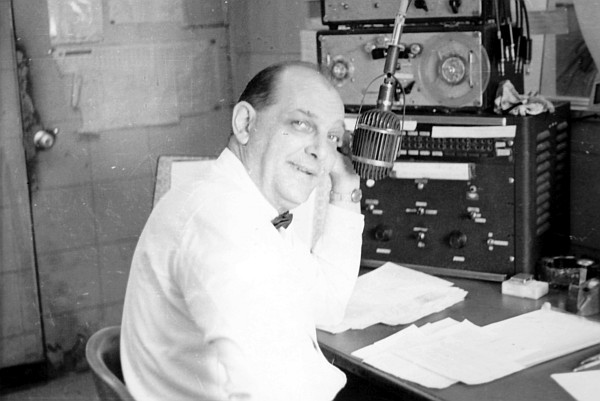
Bob Henry in the WKLO newsroom in
the Commonwealth Building
The news desk set-up was facing a wall
with a large double-pane window separating the newsroom from the control
room. The floor in the control room had been raised to accommodate all
the wiring so the DJ was looking down on the newsperson. It was actually
a pretty efficient line of sight and made it pretty easy to communicate
by hand signals or even notes. Of course we had an intercom, but it
wasn't necessary to use it that often.
As the newsperson faced the desk, all of the equipment was arrayed
around him. The desk was actually a large heavy metal office table, with
a sort of rubberized top surface. Directly in front at the center of the
equipment was a panel that contained the mike switch and switches to put
the various tape machines on the air. There was also a small patch cord
panel to allow switching audio to-and-from different tape machines or
sources. I can't recall exactly, but I believe we had two or three tape
machines that were sort of permanent fixtures in the newsroom. One of
them was a fairly small Ampex reel-to-reel recorder that was what passed
for "portable" in the late '50s. It had a snap-on top and you could
carry it with a suitcase-type handle. The other one or two machines were
Magnacorders that were still regarded as "portable", but were much
larger and heavier than the Ampex. We also had telephone-recording
capability built in to the switching box so we could record on any of
the tape machines.
Another feature of the set-up was an electronic telegraph key that was
used as a separator on our "bannerline" reports at :25 in non-drive time
periods. We also had a reverb button that was used on newscasts to
highlight the name of the place the story related to.
Of course we also had the ever dependable Royal manual typewriter that
all of us loved because it had such an easy carriage mechanism and you
could type fast without a lot of wear and tear on your fingers. (Note:
When I left WKLO in 1973, I had never used an electric typewriter.) As
the years went on these typewriters became harder to find, and we were
always looking for them as back-ups. Another personal note: to this day
I have never learned touch typing, but am still a very fast
hunt-and-peck typist.
During this time in the early '60s transistors were just beginning to
appear, and we were able to find a reel-to-reel portable tape recorder
made by Norelco that was fairly effective for street work. However these
machines were notoriously unreliable, and often would jam while
recording, and you would lose everything.
When we wanted to feed a tape back to the newsroom from an assignment,
we would normally call on the phone and hold the speaker up to the
mouthpiece of the phone. It was very primitive and low quality.
During this period in the early '60s we had no cartridge machines or
even cassette recorders.
One of the features of the old newsroom that most of us really liked was
the microphone. It is partially visible in the picture of Bob Henry. As
I recall it was a Western Electric model that had been a staple of
broadcasting since the '40s. I always thought it had a great
sound/presence. One of the advantages also was the fact that it had a
built-in screen that kept you from getting too close to the actual mike
pickup. This meant that you could work close to the mike without getting
a lot of extraneous pop and hiss noise. I seem to recall that this was
also a fairly directional mike. After the move to Walnut Street we were
always complaining about the new mikes.
When we moved to Walnut Street in mid-1964, I was not involved in news
at all, I was working solely as a DJ, and therefore I was not involved
in the planning and layout of the news facilities at the new location.
However, I can explain what was done.
As everyone knows, the new studios were a showcase arrangement that put
the DJ behind a ceiling-to-floor showcase windows. The DJ was only about
six feet from the window and people walking by on the sidewalk. This was
a radical departure from our previous set-up where visitors to the radio
station could not even see the DJ.
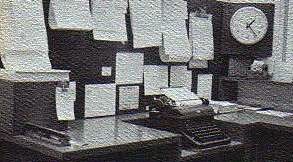
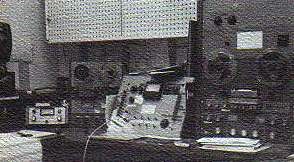
The new arrangement also
created a position in the showcase studio where the newsperson would
actually sit to deliver the newscasts. This was a major departure from
the old arrangement in which the newsperson delivered the newscasts from
the newsroom, and did not have to move to another location to deliver
the news.
The best thing about the new newsroom was that it was designed from the
ground up
to be a working newsroom. One of the problems with the original layout
was that the only way to get to the control room was through the
newsroom. This meant that a fairly large chunk of floor space was taken
up by the path to the control room. The rest of the space was highly
compact and well-organized. In the pictures you can see both sides of
the newsperson's workspace. It was all custom made to provide a "U"
shaped workspace that made it easy to reach almost everything without
having to get out of the chair. It also accommodated a lot of wiring
that previously was exposed.
The left side of the workspace included the typewriter, and spikes for
sorting the various categories of wire copy (both visible in the
picture). The right side was where all of the tape recording and editing
equipment was located. By this time we did have a cartridge
recorder/playback unit (only one). We also had three reel to reel
machines, as I recall two Ampex and one Magnacorder. One of them is not
visible in this picture. It was under the counter and was used strictly
for UPI audio. In the center of this photo is a custom made control
panel designed and built by our engineering staff which was used for
editing and recording.
In between these two sides was the center desktop section facing the
showcase studio, which included a small custom made console, mike
switch, etc. for doing live reports from the newsroom. Our array of
police and fire monitors was now largely hidden. I think some of the
actual receivers were in the basement, and just the speakers were in the
newsroom. The whole newsroom setup was a huge improvement over what we
had worked with in the Commonwealth Building. One of the big
improvements was that all of the switching between sources and machines
were hard-wired and no longer required patch cords.
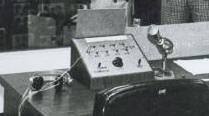
News position in the WKLO Showcase Studios
The news position in the showcase
studio was a custom-made control panel which allowed the newsperson to
take control of a couple of the cart machines in the control room which
were used for the news intro and closing format, and for the commercial
insert in the newscast. It also included control of tape machines in the
newsroom. In addition, the newsperson had their own mike switch. Once
the news intro cart was running, the DJ was free until the end of the
newscast.
On the news console, there was a switch
on the bottom left side that transferred control to the news console; in
the center was a master volume control; and on the right was the mike
switch. The parallel series of switches across the top of the panel were
tape remote start/stop buttons. As I recall this setup remained
essentially the same from the day we moved in 1964 until I left the
station in 1972. We probably changed the mike a few times trying for
better sound, but that was about it.
One of the changes I eventually made for myself is that I started using
a small transistor radio with an earplug/earphone as my on-air
headphone. I discovered that it was much more realistic because I could
actually tell what I sounded like on the air, instead of the pure "off
the board" sound fed through the regular earphones.
Later changes after I became News Director eliminated the traffic
through the newsroom to the showcase studio, and we created a small
closet for the UPI teletype to cut down the noise.
In addition to the newsroom space, we also had access to a small
production room located directly behind the newsroom that was often used
by the street reporters to dub/edit tape from the portable recorders to
tape cartridges.
As I recall the evolution of portable recorders, we started in the early
'60s with the Norelco portable reel-to-reel recorder I mentioned
earlier, and later switched to a Norelco cassette portable recorder. The
original reel machine were probably about $125 which was a lot in 1960.
When the cassette recorders first came out they were still expensive,
but gradually the price came down to the point that we would buy a new
one rather than fix an old one. These recorders were not designed for
professional use, but were very effective and generally reliable tools
for us. The biggest problem was making sure the batteries were fresh.
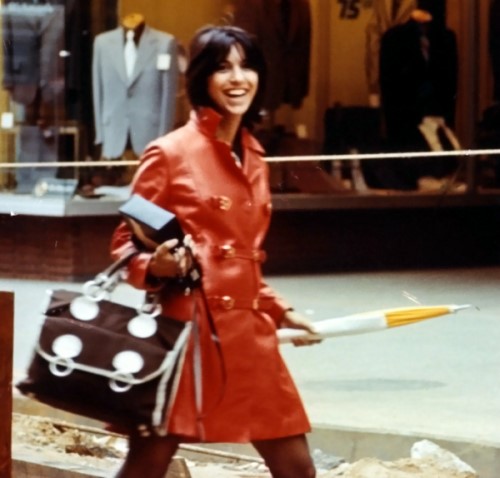
Eileen Douglas with portable
recorder
One of the really
irritating things that existed in the early 60's was the "mandatory" use
of the beep on telephone recordings. This was some kind of FCC
requirement to warn people that their conversations were being recorded.
It sounded terrible on the air and interfered with the sound quality as
well as the content. Somewhere along the way, probably in the mid-60s,
we decided to kill the automatic beep tone, and also to make it possible
to record on any of our phone lines. I don't recall how we rationalized
our way around the requirement, but part of the practical application of
it was the fact that many of these recordings were of our newspeople
calling reports or feeding tape to the station.
Our policy was that we were supposed to advise the person on the other
end that the conversation was being recorded, and then at the conclusion
ask them for permission to use it on the air. In practice, both of these
steps gradually disappeared. I don't recall that we ever had any serious
complaints.
Of what are you the proudest of as
News Director at WKLO?
What I am most proud of as far as my tenure as a newsperson and News
Director at WKLO is the revolutionary innovation and change that took
place during that period (1965-1972) to develop a unique approach to
news in modern top 40 radio. I viewed this generally as a partnership
with Terrell Metheny, Carl Truman Wiglesworth and Bill Hennes
as the Program Directors I worked with and my own creativity and quest
for continuous improvement, as well as the support of the news staff in
carrying out these changes.
Many of the innovations we made during that period were revolutionary,
and most of them didn't survive in radio for the long term. Radio news
today, in 2006, is more like what it was in the late '50s and early '60s
than what it was at WKLO in the period from 1965-1972. In short, it is
pretty dull. This is true even in stations with an all-news format.
Newscasts and other news presentations are generally forgettable as a
programming feature
One of the elements of our success was to make news a truly seamless
part of programming, woven throughout the hour and the day. If you went
away for a few minutes you might miss something worth knowing, but you
still had a chance to catch up with newscasts during the key news
periods of the day. The most revolutionary move in this area was what we
called "continuous news." There were no scheduled newscasts between noon
and 3 p.m. and between 6 p.m. and 11:55 p.m. at night, but we had
newsperson working in the newsroom during those periods, and they did
traffic reports, sports, and news stories when something new happened
that merited coverage. The intent was to make sure our audience didn't
miss anything, but to avoid straining their attention span by airing
five-minute newscasts every hour made up primarily of old news.
How did radio newsgathering and reporting change from the early '60s
when you started at WKLO until the early '70s when you left?
A lot. From the time I arrived in 1960 until Ken Rowland left in late
1964, things were fairly stable. The basic approach, on-air sound, news
gathering routine, etc. were fairly consistent. We worked hard, we had a
lot of pride in our work, and we were very competitive about getting the
stories. From 1964 through the time I left in 1972, as I have already
mentioned, change was a constant process.
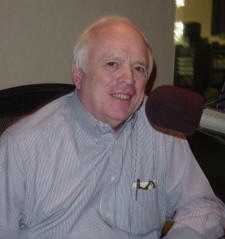
Allen Bryan in July 2006
What was your favorite part of the job?
I really liked being on the air doing
news especially in afternoon drive. I did this at two or three different
times in my career at WKLO and it was always extremely challenging and
interesting. It was also exhausting. I would usually go from 3-6 p.m.,
and during that time I would do five five-minute newscasts (3:55, 4:25,
4:55, 5:25, and 5:55 p.m.). I would also do frequent traffic condition
reports; a sports report each hour, and breaking news stories as needed.
The on-air time pattern was similar to morning drive, but usually there
wasn't much news actually happening in the morning so the pace was a
little more relaxed on normal days.
The afternoon was totally different. All of the news stories that had
been developing or breaking during the day were now piling up, and new
stuff was happening between every newscast. When I was finished with one
newscast, the 25-minute countdown clock was ticking toward the next one.
Often the next newscast could be entirely new with nothing carried over
from the last one. It was not unusual to have a newsperson calling in a
story as I was going on the air. I would start the recorder, go into the
studio to start the newscast, then when the commercial was running in
the newscast, I would run back and cue up the tape that had just been
called in. It was almost always a very pressure-filled and noisy three
hours.
What was your least favorite?
My least favorite part of the job was
dealing with problem employees. This was my first job as a manager or
supervisor and I had absolutely no training or experience in dealing
with the "problem employee" issues that invariably occur. One of the
most important lessons I learned quickly is that you can't really be
buddies with the people who work for you. I was used to being one of the
guys for several years at WKLO before I was named News Director and I
really had an "employee" perspective. I had to change that right away,
and I benefited from that lesson for the rest of my career no matter
where I worked.
Related Links
Allen Bryan Audio Interview
1967 WKLO News
Article
Late 60s News Flyer- Page
1
Late 60s News Flyer- Page
2
Late 60s News Flyer- Page
3
Late 60s News Flyer- Page
4